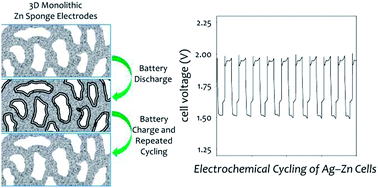Wiring zinc in three dimensions re-writes battery performance—dendrite-free cycling†
Abstract
Zinc-based batteries offer a safe, inexpensive alternative to fire-prone lithium-based batteries, but zinc-based batteries do not exhibit sufficient rechargeability—yet. Breaking through the centuries-old roadblock to zinc-based rechargeable batteries requires rethinking the electrode structure in order to control how zinc converts to zinc oxide during battery discharge and how the oxide is reversed back to metal upon recharging. We address the problems of inefficient zinc utilization and limited rechargeability by redesigning the zinc electrode as a porous, monolithic, three-dimensional (3D) aperiodic architecture. Utilization approaches 90% (728 mA h gZn−1) when the zinc “sponge” is used as the anode in a primary (single-use) zinc–air cell. To probe rechargeability of the 3D Zn sponge, we cycled Zn–vs.–Zn symmetric cells and Ag–Zn full cells under conditions that would otherwise support dendrite growth, and yet the Zn sponges remain dendrite-free after extensive cycling up to 188 mA h gZn−1. By using 3D-wired zinc architectures that innately suppress dendrite formation, all zinc-based chemistries can be reformulated for next-generation rechargeable batteries.


 Please wait while we load your content...
Please wait while we load your content...